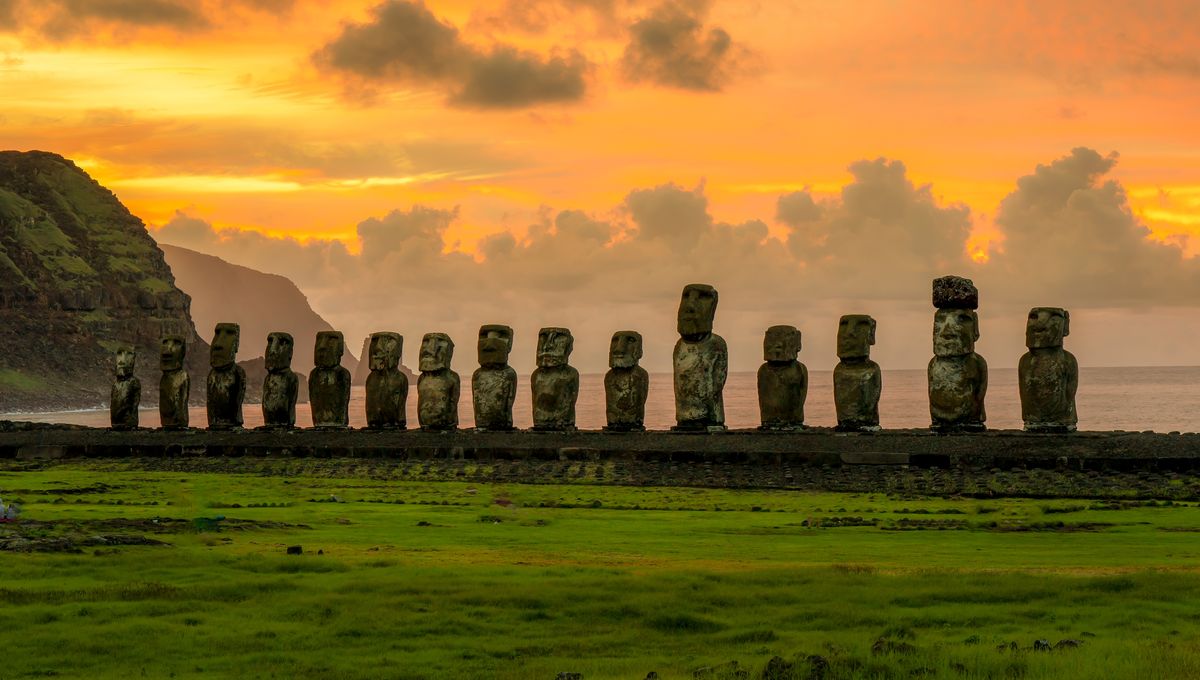
In addition to its iconic collection of monumental moai, Easter Island is famed for having hosted one of the most disastrous population declines in history, as the ancient locals apparently ravaged their homeland’s resources, triggering an ecological catastrophe that doomed them all. At least, that’s how the story goes, although new research has flipped the popular Easter Island narrative on its giant head, suggesting that the remote isle’s inhabitants actually developed a sustainable model for living and never experienced any dramatic collapse.
Also known as Rapa Nui, the small landmass in the southeastern Pacific Ocean covers just 163.3 square kilometers (63 square miles) and features highly weathered, depleted soils that lack many of the key nutrients needed for growing crops. When the first Europeans arrived in 1722, they encountered a local population of around 3,000 people, although the presence of around 1,000 huge stone heads on the island hinted at a much larger workforce at some point in the past.
To estimate the size of this former community, researchers have focused on the existence of so-called rock gardens, which the ancient inhabitants of Rapa Nui used to increase soil productivity prior to the arrival of Europeans. By layering rocks of various sizes, the locals were able to prevent moisture loss from the soil while also enhancing nutrient content, enabling the cultivation of sweet potatoes in the spaces between this “lithic mulch”.
Research conducted this century using satellite images has indicated that ancient rock gardens may have covered up to 21.1 square kilometers (8.1 square miles) of the island. Calculating the calories that could be obtained from sweet potatoes grown in these plots, scientists have estimated that Rapa Nui may have once supported a population of around 17,000 people.
That’s an awful lot of residents for such a small, desolate place, and it’s widely believed that this population eventually outgrew the island’s meager resources, resulting in ecological and social collapse.
However, these previous rock garden counts are likely to be highly inaccurate as they don’t adequately distinguish between human-made lithic allotments and natural rocky outcrops. To set the record straight, the authors of a new study trained a machine-learning model to accurately identify genuine rock gardens from satellite imagery by looking for areas of increased soil moisture and nitrogen content, rather than just rocks.
After five years of analysis, the researchers concluded that just 0.76 square kilometers (0.3 square miles) of Easter Island is covered in rock gardens. Based on the quantity of sweet potatoes that could be harvested from these plots, the authors estimate that the island’s agriculture never supported more than about 2,000 people.
Isotopic analysis of teeth and bones from ancient corpses on Rapa Nui has indicated that seafood and other crops like sugarcane, bananas, taro, and yams also made up about 35 to 45 percent of the local diet. Combining the calorific value of all the island’s resources, the researchers say that at any given time, Rapa Nui could have supported a maximum population of about 3,901 people.
“This shows that the population could never have been as big as some of the previous estimates,” said study author Dylan Davis in a statement. In their write-up, the researchers explain that the figures proposed by prior studies were probably “between five and 20 times too high.”
The community encountered by those early European visitors may not, therefore, have been the vestiges of a once populous citizenry, but was instead probably representative of the kind of society that had always existed on Easter Island.
Such a conclusion radically rewrites the history of Rapa Nui, doing away with the idea of irresponsible resource exploitation and population overshoot. “Our results add to a growing body of empirical research showing that Rapa Nui represents a prime example of how an isolated population with limited natural resources created a sustainable subsistence system, maintaining their numbers within the limitations of environmental carrying capacity,” write the researchers.
“The lesson is the opposite of the collapse theory,” adds Davis. “People were able to be very resilient in the face of limited resources by modifying the environment in a way that helped.”
The study is published in the journal Science Advances.
Source Link: Easter Island’s Catastrophic Population Collapse Probably Never Actually Happened